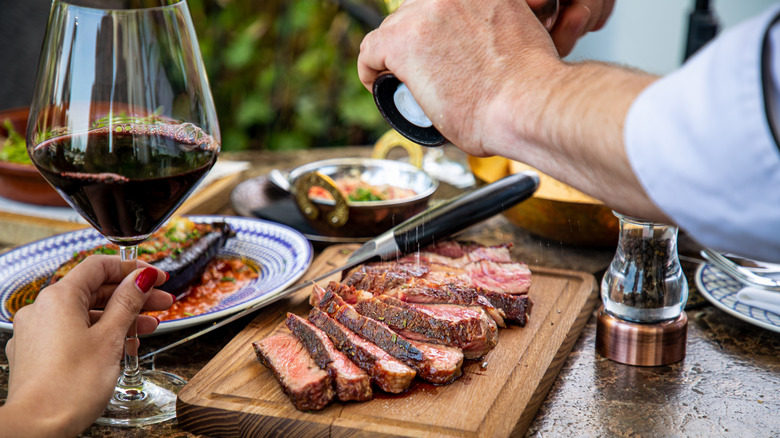The Red Wine And Meat Pairing Advice You Should Take With A Grain Of Salt
It is — supposedly — common knowledge that red wine pairs best with red meat, white wine pairs best with white meat and seafood, and bitter wines pair best with fatty proteins. But according to Master of Wine Tim Hanni, it may not be that simple. In a strong stance, he told Food & Wine, "The idea that the 'fats and protein in the meat will smooth out the wine' is an easily disproved myth backed up by pseudo-science." He says that the fat and protein can actually make a red wine seem even more bitter and astringent.
So what's the crucial ingredient that turns bitter wine round and sippable? According to Hanni: salt. Various studies have shown that the right amount of salt will inhibit the perception of bitter flavors, up to a certain point. Too bitter, and the salt doesn't keep up. Too much salt, and the perception of sourness and bitterness actually develops more. The combo of salt on a well-seasoned steak and a big, bold, tannic red like a merlot, though, is balanced enough to let both the meat and the wine's flavors shine.
If you're taking the traditional pairing advice with a grain of salt, what heuristics can you follow? Master Sommelier and the Founder and Chief Executive Officer of the San Francisco Wine School David Glancy recommends pairing based on the intensity of flavor. The more bold a meal, the more bold the wine — and when the meal is more delicate, the wine should follow suit.
New wine pairing rules
As you'd balance spices and flavors within your meal, you should balance flavors between your meal and your wine. An easy way to get into this, as David Glancy recommends, is to match how powerful your meal is with how powerful your wine is. Take salmon recipes, for instance. A delicate salmon glazed with lemon and dill would love a citrusy, lighter, crisp white wine like a sauvignon blanc, while a spicy salmon with Thai chilis would do better with a slightly sweeter, floral white like gewurztraminer. A blackened salmon with bleu cheese sauce can stand up to a red wine — and the more pungent the bleu cheese, the bolder a red you can choose, like a malbec or even a cabernet sauvignon.
With red meat, the same concept applies. Tim Hanni loves dense merlots with spicy barbecue beef ribs. Glancy likes to match salty and sweet, pairing filet mignon and a bleu cheese compound butter with a round, fruity zinfandel. Timm Crull, a Napa Valley winemaker and proprietor of The Terraces, warns not to take it too far; he isn't a particular fan of aged beef and fruity reds, instead preferring to pair an earthy, smokey, salty aged ribeye with the earthier notes of a cabernet franc. Glancy suggests that lighter red meat dishes like veal piccata can be paired with white wine: crisp whites like pinot grigio will highlight the lemon, while rounder, lightly oaked whites like soave can balance the acidity.
Choosing wine for intensity
There are things to watch for that will tell you what's in the bottle you're eyeing. The biggest tell-tale sign is the ABV percentage. The higher the alcohol content, usually, the bolder the wine. Geography affects wine and will tell you plenty about what you're getting. Cool region wines will generally be crisper, higher acidity, lower sugar, and lower ABV. Grapes grown in cool climates develop lower brix levels, or sugars, before they're harvested. Hot climates promote higher brix levels and fuller, more concentrated flavors — the wine from an intensely hot climate will be similarly intense (and you'll want to pair it with an intensely flavored, higher salt meal).
Seasonal weather from year to year will affect this as well. Late-season rains and cool weather will slightly mute the flavors, heighten the acidity, and lower the sugars. Hot and draught-like conditions will do the opposite, developing higher sugars, bigger body, and bolder flavors. If you're comparing vintages of the same wine but you know 2016 had a really cool and rainy summer but 2018 was really hot and dry, pair the 2016 with a lighter meal and the 2018 with a bolder one. And consider the salt, too — a wine from highly mineral, volcanic soils will have higher perceived salinity. Unless you like licking a salt block, don't pair this with a heavily salted meal, or it'll take over the flavor in both. Instead, choose a wine like syrah, merlot, cabernet, or zinfandel for balance.


